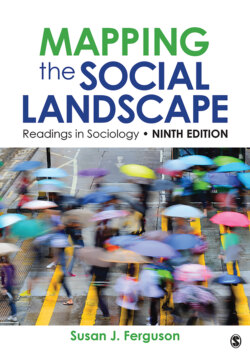Читать книгу Mapping the Social Landscape - Группа авторов - Страница 21
На сайте Литреса книга снята с продажи.
Notes
Оглавление1. The conditions I observed in El Paso were not much different from those described by D. Thompson in her 1960 article, “Are Women Bad Employers of Other Women?” Ladies’ Home Journal: “Quarters for domestic help are usually ill placed for quiet. Almost invariably they open from pantry or kitchen, so that if a member of the family goes to get a snack at night he wakes up the occupant. And the live-in maid has nowhere to receive a caller except in the kitchen or one [of] those tiny rooms.” “As a general rule anything was good enough for a maid’s room. It became a catchall for furniture discarded from other parts of the house. One room was a cubicle too small for a regular-sized bed.” Cited in Linda Martin and Kerry Segrave, The Servant Problem: Domestic Workers in North America (Jefferson, NC: McFarland, 1985), p. 25.
2. David Katzman addresses the “servant problem” in his historical study of domestic service, Seven Days a Week: Women and Domestic Service in Industrializing America (Chicago: University of Illinois Press, 1981). Defined by middle-class housewives, the problem includes both the shortage of servants available and the competency of women willing to enter domestic service. Employers’ attitudes about domestics have been well documented in women’s magazines. Katzman described the topic as “the bread and butter of women’s magazines between the Civil War and World War I”; moreover, Martin and Segrave, The Servant Problem, illustrate the continuing presence of articles on the servant problem in women’s magazines today.
3. Lillian Pettengill’s account Toilers of the Home: The Record of a College Woman’s Experience As a Domestic Servant (New York: Doubleday, 1903) is based on two years of employment in Philadelphia households.
4. Ruth Schwartz Cowan, More Work for Mother: The Ironies of Household Technology from the Open Hearth to the Microwave (New York: Basic Books, 1983), p. 228.
5. Earning money as domestic workers to pay college expenses not covered by scholarships is not that uncommon among other women of color in the United States. Trudier Harris interviewed several African American women public school and university college teachers about their college-day experiences in domestic service. See From Mammies to Militants: Domestics in Black American Literature (Philadelphia: Temple University Press, 1982), pp. 5–6.
6. Judith Rollins, Between Women: Domestics and Their Employers (Philadelphia: Temple University Press, 1985); Bonnie Thornton Dill, “Across the Boundaries of Race and Class: An Exploration of the Relationship between Work and Family among Black Female Domestic Servants” (Ph.D. dissertation, New York University, 1979); Judith Rollins, “‘Making Your Job Good Yourself’: Domestic Service and the Construction of Personal Dignity,” in Women and the Politics of Empowerment, ed. Ann Bookman and Sandra Morgen (Philadelphia: Temple University Press, 1988), pp. 33–52; Soraya Moore Coley, “‘And Still I Rise’: An Exploratory Study of Contemporary Black Private Household Workers” (Ph.D. dissertation, Bryn Mawr College, 1981); Evelyn Nakano Glenn, Issei, Nisei, War Brides: Three Generations of Japanese American Women in Domestic Service (Philadelphia: Temple University Press, 1986).
7. In some cases, it was important to let women know that my own background had involved paid housework and that my mother and sister were currently employed full-time as private household workers. Sharing this information conveyed that my life had similarities to theirs and that I respected them. This sharing of information is similar to the concept of “reciprocity” (R. Wax, “Reciprocity in Field Work,” in Human Organization Research: Field Relationships and Techniques, ed. R. N. Adams and J. J. Preiss [New York: Dorsey, 1960], pp. 90–98).
8. Clark Knowlton, “Changing Spanish-American Villages of Northern New Mexico,” Sociology and Social Research 53 (1969): 455–75.
9. Nancie Gonzalez, The Spanish-Americans of New Mexico (Albuquerque: University of New Mexico Press, 1967), p. 123.
10. William W. Winnie, “The Hispanic People of New Mexico” (Master’s thesis, University of Florida, 1955).
11. Thomas J. Malone, “Recent Demographic and Economic Changes in Northern New Mexico,” New Mexico Business 17 (1964): 4–14.
12. Donald N. Barrett and Julian Samora, The Movement of Spanish Youth from Rural to Urban Settings (Washington, DC: National Committee for Children and Youth, 1963).
13. Clark Knowlton, “The Spanish Americans in New Mexico,” Sociology and Social Research 45 (1961): 448–54.
14. See Paul A. Walter, “The Spanish-Speaking Community in New Mexico,” Sociology and Social Research 24 (1939): 150–57; Thomas Weaver, “Social Structure, Change and Conflict in a New Mexico Village” (Ph.D. dissertation, University of California, 1965); Florence R. Kluckhohn and Fred L. Stodtbeck, Variations in Value Orientations (Evanston, IL: Row, Peterson, 1961); Frank Moore, “San Jose, 1946: A Study in Urbanization” (Master’s thesis, University of New Mexico, 1947); Donald N. Barrett and Julian Samora, The Movement of Spanish Youth (Washington, DC: National Committee for Children and Youth, 1963).
15. David Katzman, Seven Days a Week (Chicago: University of Illinois Press, 1981), pp. 269–70.
